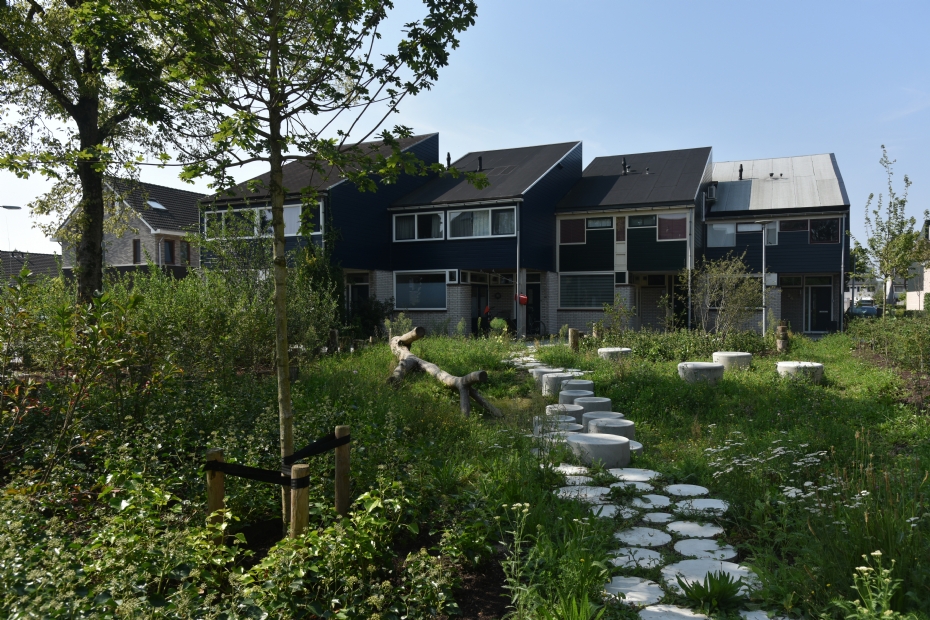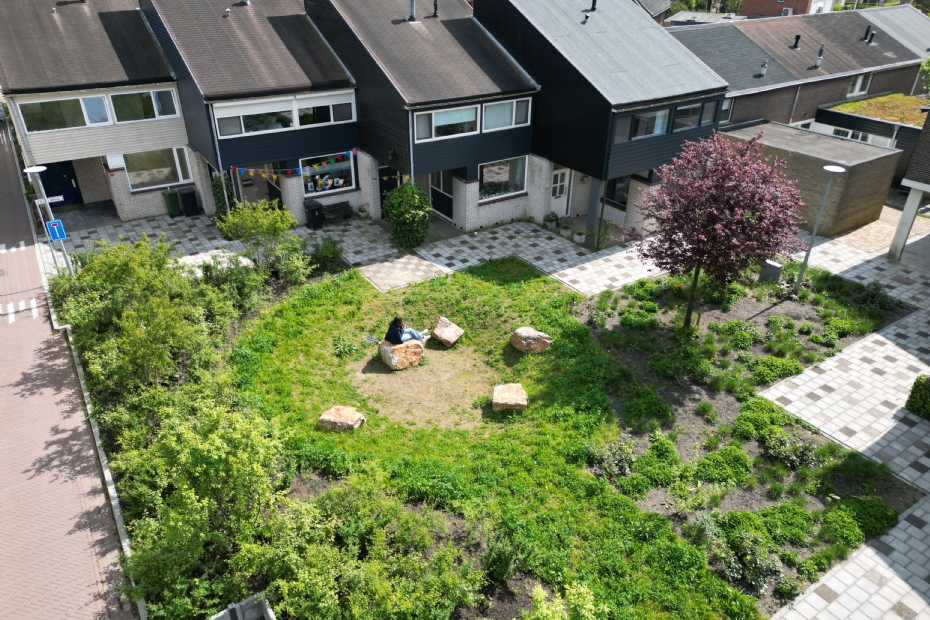Greening in focus: Wijk de Mosterdhof in Westervoort |
|
|
|
|
 |
| 140 sec |
Total renovation while preserving its character
The 1970s neighborhood Mosterdhof in Westervoort is undergoing a green transformation. Under the name Mooi](https://mooimosterdhof.nl/]Mooi) Mosterdhof, the municipality is working with residents on a climate-resilient and livable community. SmitsRinsma plays a role in the implementation phase of the green plan. The engineering firm advises on plant selection and the design of recessed planting beds, and supervises the execution.
| Mosterdhof in Westervoort (Image via Veenenbos en Bosch Landscape Architects) |
"The question was how the existing neighborhood, with its characteristic urban design, could be made more sustainable and greener, both architecturally and in terms of landscape," begins Ivo Stevens, director and project leader at SmitsRinsma, in the interview. "We handled the landscape aspect and redesigned the public space while preserving the character of the neighborhood. Existing roads and utility routes were maintained and fully renovated, and sewer lines were replaced where necessary. Within those structures we created a new layout with more green and less gray."
Disconnecting street drains
Where possible, SmitsRinsma also took care of disconnecting rainwater drainage. This is currently happening in many other projects in the Netherlands as well. In this process, some of the street drains are removed from street profiles. Rainwater that falls on the road is then directed into planting beds, where it benefits plant growth. Stevens: "Because the roadways often created an asymmetrical layout, we couldn't always realize green drainage on both sides. Where the green-gray-green alternation wasn't possible, we at least included one side. This way, half of the rainwater flows into the planting bed, while the other half goes into a drain."
|
|
"The question was how the existing neighborhood, with its characteristic urban design, could be made more sustainable and greener, both architecturally and in terms of landscape."
| |
|
Grass parking
In addition, SmitsRinsma chose to realize climate-adaptive parking where possible. Grass pavers were used, allowing rainwater to infiltrate directly into the soil. "We also kept the groundwater level in mind," says Stevens. "Along the floodplains, water pushes into the neighborhood. The extra rainwater absorption had to cause no problems; the buffering must be able to capture and drain sufficient water during extreme showers and ensure retention during dry periods. With such measures we can create more green in a paved environment. In the long run, that provides a tree canopy, shade, and additional cooling in the neighborhood."
 | | Mosterdhof Westervoort (Photo by Jeroen Bosch) |
|
|
Intensive citizen participation
SmitsRinsma reused as much existing material as possible, such as paving materials. Several courtyards were also redesigned. Stevens: "In a process of intensive citizen participation, the wishes of current residents were collected block by block. When the redesign plan was ready, residents were asked whether their ideas were sufficiently reflected."
Also applicable in other cities
Thanks to all the sustainability and greening measures, this old neighborhood is ready for decades to come, truly future-proof. And all that while preserving existing buildings and trees. "The neighborhood has come back to life. People spend more time in an environment they enjoy and meet others there, which in turn enhances social cohesion. The process behind Mooi Mosterdhof could also be rolled out in other cities. It is important to have clarity about the position of cables and pipelines beforehand; this often requires considerable research. You need to make sure that everything above ground also fits below ground. If you want to lower parts of public space to create deeper planting beds for rainwater buffering, you must be certain that it is feasible in that location. If you decide to relocate cables and pipelines, keep in mind that it takes a lot of effort to coordinate with utility companies — and that's before even considering the costs."
|
|
An old neighborhood can be future-proof again thanks to sustainability and greening measures.
| |
|
Gelderland Spatial Quality Award for Mooi Mosterdhof
The Mooi Mosterdhof project won the Gelderland Spatial Quality Award 2024 in the Housing & Living Environment category. The theme of this edition was "Feeling at home." The award is presented every two years to a project that contributes in a smart and creative way to a pleasant living environment in Gelderland.
|
From neighborhood development plan to implementation: read more here(https://www.westervoort.nl/wijkontwikkelingsplan-mooi-mosterdhof]here[/LINK)], and find a detailed explanation of green management in Mosterdhof in](https://mooimosterdhof.nl/wp-content/uploads/2025/03/Groenboek-Mosterdhof_maart-2025.pdf]in) this PDF.
 | | Aerial view of gardens in Mosterdhof Westervoort (Image via Veenenbos en Bosch Landscape Architects) |
|
|
This article was previously published on 29 September 2025 on the website](https://www.stad-en-groen.nl/article/51221/vergroening-in-beeld-wijk-de-mosterdhof-in-westervoort]website) of Stad + Groen.
| LOG IN
with your email address to respond.
|
|
|
| There are no comments yet. |
|
| |
Anyone can place small ads for free through their own account.
Place a free ad
|
|
|
|